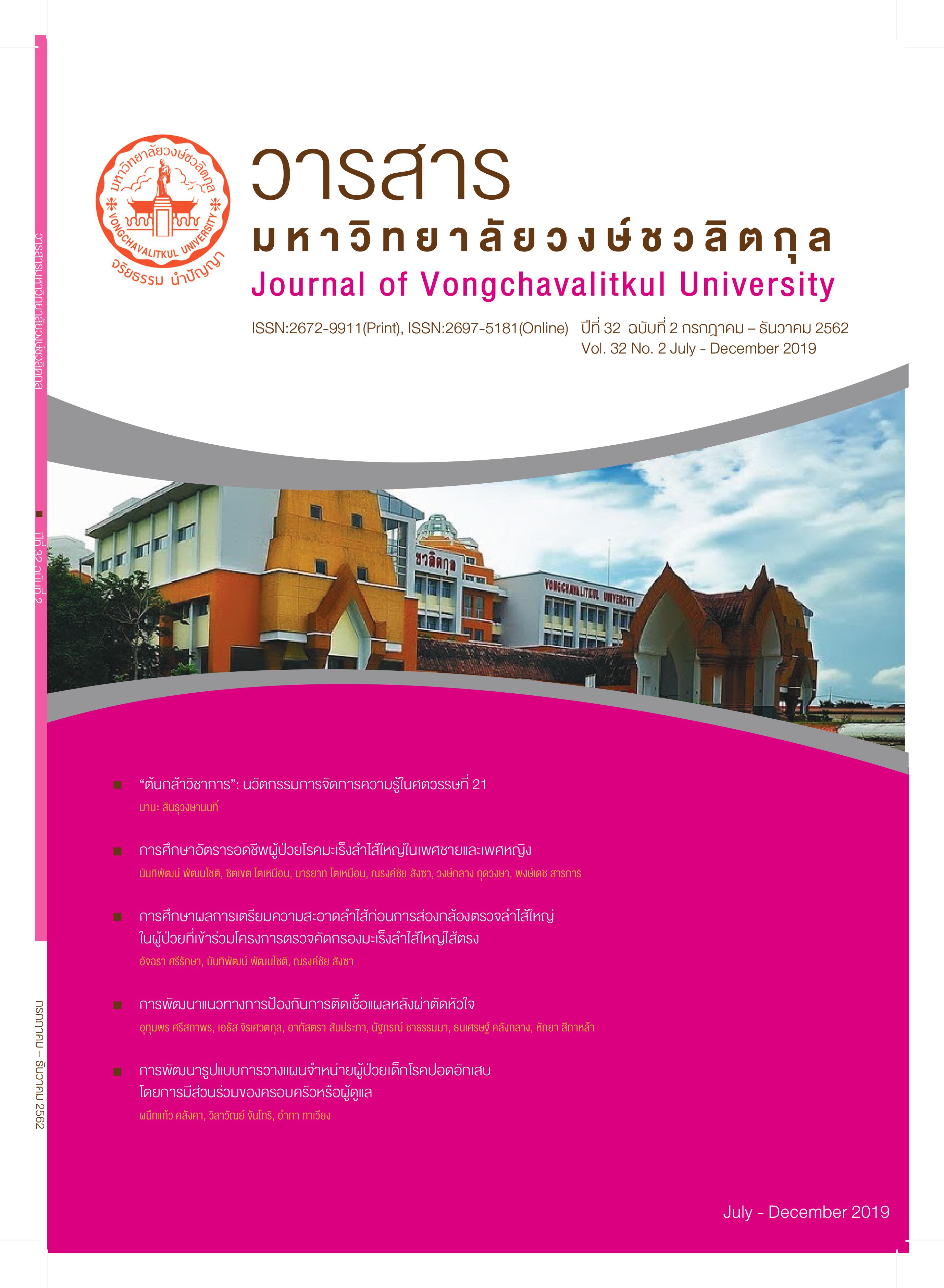A Development of Guidelines for Prevention of Surgical Site Infection after Cardiac Surgery
Main Article Content
Abstract
Objective: of the study was to develop guidelines for prevention of surgical site infection after cardiac surgery in a tertiary care center hospital.
Methods: This was a participatory action research study conducted in a tertiary care center hospital. They were 27 staffs in multidisciplinary team, 90 patients with heart surgery and 84 relatives, a total of 201 participants. The study conducted from January to September 2017, divided into 4 phases: Phase 1: studying the situation of risk factors of infection, wound care and postoperative care after heart surgery; Phase 2: presenting the situation and identifying guidelines; Phase 3: implementing of the guidelines at Cardiovascular-Thoracic Surgical Intensive Care Unit and Phase 4: making conclusion and evaluation. The tools used in the study were 1) data recording form of situation, 2) observation form for care practice, 3) satisfaction questionnaire and 4) demographic data form. Data were collected by observation, inquiry, brainstorming and answering a questionnaire. Percentage, mean, standard deviation and content analysis were used to analyze data.
Results of the study displayed a guidelines for prevention of surgical site infection after Cardiac surgery consisted of 8 items; 1) data of wound transferring each shift, 2) wound care and evaluation, 3) wound dressing with 2% chlorhexidine in 70% alcohol, 4) applying chest band, 5) controlling of blood sugar, 6) providing health education, 7) Surgical site infection surveillance, and 8) using registered nurse for evaluation. Percentage of guidelines compliance was 92 percent. Personnel satisfaction at a high level was 100 percent and patient and family satisfaction at a high level was 90 percent. Surgical site infection rate was reduced from 0.75 in 2016 to 0.41 in 2017. Accordingly, guidelines for prevention of surgical site infection could help reduce surgical site infection after cardiac surgery in Cardiovascular and Thoracic Intensive Care Unit.
Article Details
References
2. ธนะพัทธ์ พิบูลย์บรรณกิจ. (2558). ภาวะการติดเชื้อที่เกิดขึ้นภายหลังการผ่าตัดของระบบหัวใจและทรวงอก. (ออนไลน์) http://thaists.org/news_files/news_file_396.pdf. วันที่ 2 มกราคม 2560.
3. ไพบูลย์ โล่สุนทร. (2552). ระบาดวิทยา (Epidemiology). กรุงเทพมหานคร: คณะแพทย์ศาสตร์ จุฬาลงกรณ์มหาวิทยาลัย. โรงพิมพ์จุฬาลงกรณ์มหาวิทยาลัย.
4. โรงพยาบาลขอนแก่น. (2558). คู่มือนโยบายโรงพยาบาลขอนแก่น. ขอนแก่น: โรงพยาบาลขอนแก่น.
5. โรงพยาบาลขอนแก่น. (2559). ทะเบียนผู้ป่วยหอผู้ป่วยหนักศัลยกรรมหัวใจและทรวงอก: ทะเบียนผู้ป่วยผ่าตัดหัวใจ (2558-2559). ขอนแก่น: โรงพยาบาลขอนแก่น.
6. วงเดือน สุวรรณคีรี และยุพเรศ พญาพรม. (2560). การป้องกันการติดเชื้อที่ตำแหน่งผ่าตัด. วารสารพยาบาลศาสตร์ จุฬาลงกรณ์มหาวิทยาลัย, 29(2) : 15-28.
7. สันต์ ใจยอดศิลป์. (2553). ความเสี่ยงของการผ่าตัดหัวใจ. (ออนไลน์) http://visitdrsant.blogspot.com/2010/09/blog-post_07.html. เข้าถึงเมื่อ 24 มีนาคม 2559.
8. Anderson, D. J., Podgorny, K., Berrios-Torres, S. I., Bratzler, D. W., Dellinger, E. P., Greene,
L....& Kaye, K. S. (2014). Strategies to prevent surgical site infections in acute care hospitals: 2014 update. Infection Control and Hospital Epidemiology, 35(6): 605-627.
9. hospitals: 2014 update. Infection Control and Hospital Epidemiology, 35(6): 605-627.
10. Berrios-Torres, S. I., Umscheid, C. A., Bratzler, D. W., Leas, B., Stone, E. C., Kelz, R. R.…&
Schecter, W. P. (2014). Draft guideline for the prevention of surgical site infection. Retrieved April 8, 2017 from www. jscva/files/CDC-SSI_Guideline_Draft2014.pdf
11. Fei, Q., Li, J., Lin, J., Li, D., Wang, B., Meng, H., & Yang, Y. (2015). Risk factors for surgical
site infection following spinal surgery: A meta-analysis. World Ne u r o s u r g e r y ,
d o i : 1 0 . 1 0 1 6 / j . wneu.2015.05.059.
12. Kemmis S, Mc., & Taggart R. (2000). Participatory action research. In N. Denzin & Y. Lincoln (Eds.), Handbook of qualitative research (2nd eds.). Thousand Oaks CA: Sage; pp: 567-605.
13. Korol, E., Johnson, K., Waser, N., Sifakis, F., Jafri, H. S., Lo, M., & Kyaw, H. (2013). A
systematic review of risk factors associated with surgical site infections among surgical
patients. Public Library of Science ONE, 8(12): e83743.
14. Lindblom, R. P. et al. (2015). “Outcomes following the implementation of a quality
control campaign to decrease sternal wound infections after coronary artery bypass
graft” BMS Cardiovasc Discord, 2(20) 154-158.
15. Rabih, O. Darouiche, M. D., et al. (2010). Chlorhexidine–Alcohol versus Povidone–Iodine
for Surgical-Site Antisepsis. New England Journal of Medicine, 36(2) 18-26.
16. World Health Organization. (2009). WHO guidelines for safe surgery 2009: safe surgery
saves lives. Geneva: World Health Organization.
17. Zhang, Y., Zheng, Q. J., Wang, S., Zeng, S. X., Zhang, Y. P., Bai, X. J., & Hou, T. Y. (2015).
Diabetes mellitus is associated with increased risk of surgical site infections: A meta-analysis of perspective cohort studies. American Journal of Infection Control, 43: 810-815.


